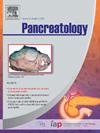内镜超声引导下组织采集用于胰腺癌全面基因组分析的可行性和临床应用:一项系统综述和荟萃分析。
IF 2.8
2区 医学
Q2 GASTROENTEROLOGY & HEPATOLOGY
引用次数: 0
摘要
背景:超声内镜引导下的组织采集(EUS-TA)已成为诊断胰腺导管腺癌(PDAC)的必要手段,并越来越多地用于全面基因组分析(CGP),以推进精准医疗。本系统综述和荟萃分析评估了EUS-TA样本用于PDAC患者CGP的可行性和临床应用。方法:到2023年10月,我们在PubMed、EMBASE和Cochrane图书馆进行了全面系统的文献检索。主要结果包括测序成功率,四个主要驱动基因和可操作基因的检出率,以及与其他样本类型或方法的一致性率。结果:共有23项研究符合纳入标准。合并测序成功率为83.9%[95%置信区间(CI): 75.8- 89.7%]。细针穿刺和活检的测序成功率无显著差异(优势比1.77,95% CI 0.70-4.47)。元回归分析显示,CGP的最低DNA要求显著影响测序成功率。K-ras的合并突变率为86.4% (95% CI 83.6-88.8),而潜在可操作突变的合并突变率为17.7% (95% CI 12.8-23.8)。eus引导标本的CGP结果与手术标本的一致性率为81.6% (95% CI 68.2-90.1)。结论:利用eus - ta衍生样本对PDAC进行全面的基因组分析在临床环境中是可行的。大约18%的接受CGP的患者表现出潜在的可操作突变,突出了个性化治疗方法的潜力。本文章由计算机程序翻译,如有差异,请以英文原文为准。
Feasibility and clinical utility of endoscopic ultrasound-guided tissue acquisition for comprehensive genomic profiling in pancreatic cancer: A systematic review and meta-analysis
Background
Endoscopic ultrasound-guided tissue acquisition (EUS-TA) has become essential for diagnosing pancreatic ductal adenocarcinoma (PDAC) and is increasingly utilized for comprehensive genome profiling (CGP) to advance precision medicine. This systematic review and meta-analysis assess the feasibility and clinical utility of EUS-TA samples for CGP in PDAC.
Methods
We conducted a thorough systematic literature search in PubMed, EMBASE, and the Cochrane Library up to October 2023. Key outcomes included sequencing success rates, detection rates of four major driver genes and actionable genes, and concordance rates with other sample types or methodologies.
Results
A total of 23 studies met the inclusion criteria. The pooled sequencing success rate was 83.9 % [95 % confidence interval (CI): 75.8–89.7 %]. No significant difference was observed in sequencing success rates between fine needle aspiration and biopsy (odds ratio 1.77, 95 % CI 0.70–4.47). Meta-regression analysis revealed that the minimum DNA requirement for CGP significantly influenced sequencing success rates. The pooled mutation rate for K-ras was 86.4 % (95 % CI 83.6–88.8), while potentially actionable mutations had a pooled rate of 17.7 % (95 % CI 12.8–23.8). The concordance rate between CGP results from EUS-guided samples and surgical specimens was 81.6 % (95 % CI 68.2–90.1).
Conclusion
Comprehensive genomic profiling of PDAC using EUS-TA-derived samples demonstrated feasibility in clinical settings. Approximately 18 % of patients undergoing CGP exhibited potentially actionable mutations, highlighting the potential for personalized therapeutic approaches.
求助全文
通过发布文献求助,成功后即可免费获取论文全文。
去求助
来源期刊

Pancreatology
医学-胃肠肝病学
CiteScore
7.20
自引率
5.60%
发文量
194
审稿时长
44 days
期刊介绍:
Pancreatology is the official journal of the International Association of Pancreatology (IAP), the European Pancreatic Club (EPC) and several national societies and study groups around the world. Dedicated to the understanding and treatment of exocrine as well as endocrine pancreatic disease, this multidisciplinary periodical publishes original basic, translational and clinical pancreatic research from a range of fields including gastroenterology, oncology, surgery, pharmacology, cellular and molecular biology as well as endocrinology, immunology and epidemiology. Readers can expect to gain new insights into pancreatic physiology and into the pathogenesis, diagnosis, therapeutic approaches and prognosis of pancreatic diseases. The journal features original articles, case reports, consensus guidelines and topical, cutting edge reviews, thus representing a source of valuable, novel information for clinical and basic researchers alike.
 求助内容:
求助内容: 应助结果提醒方式:
应助结果提醒方式:


